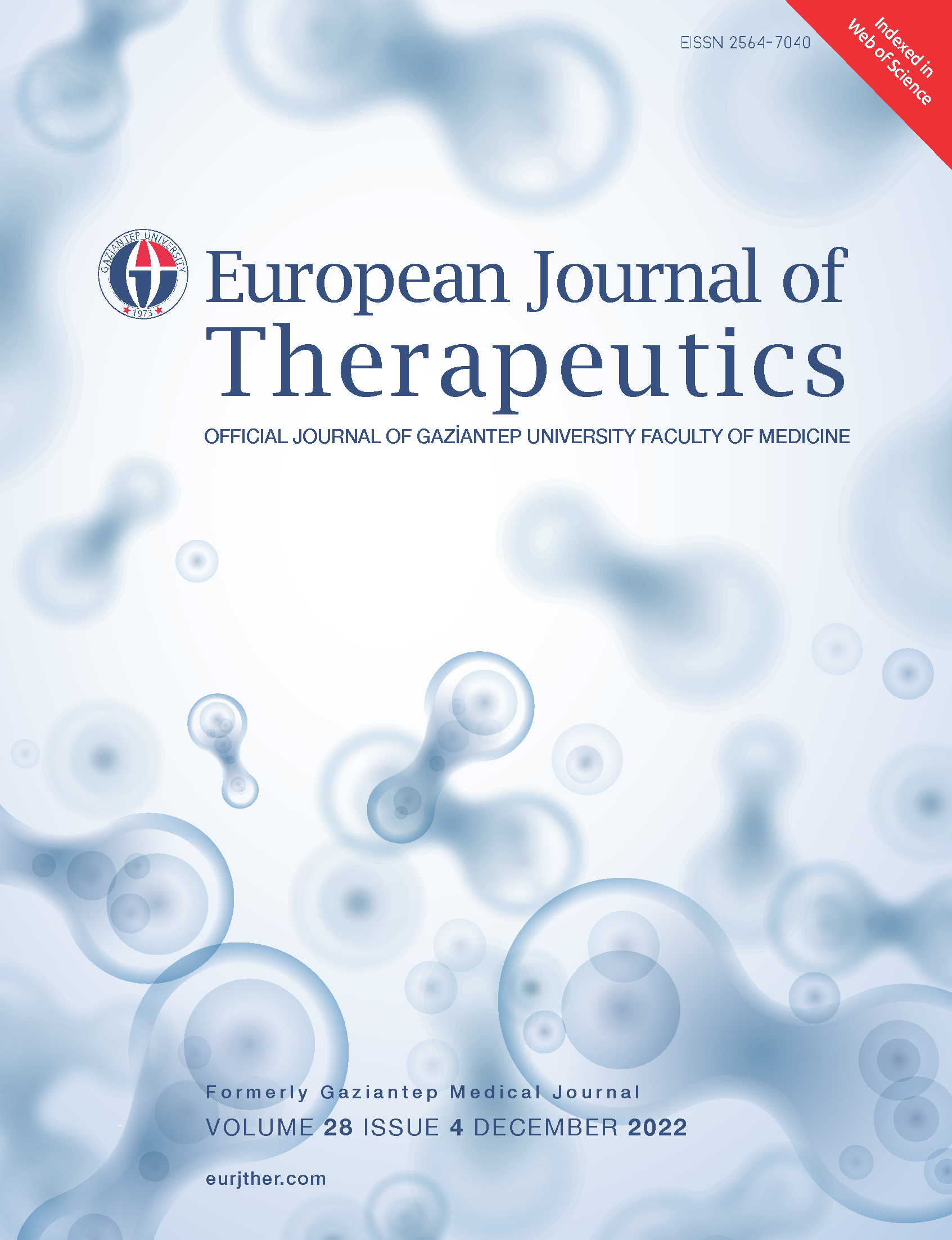Comparison of Pineal Gland Volume Between Patients with Fibromyalgia and Healthy Controls Running Title: Pgv in Fibromyalgia
DOI:
https://doi.org/10.58600/eurjther-28-4-0104Keywords:
Fibromyalgia syndrome, pineal gland volume, functional pineal gland volume, pineal gland magnetic resonance imagingAbstract
Objectives: The pineal gland is an important neuroendocrine organ accounting for the melatonin secretion and chronobiology that regulate circadian rhythm. This study was designed to compare pineal gland volume (PGV) with healthy controls and patients with fibromyalgia syndrome (FM), in which sleep quality and efficiency is reduced. Patient and
Methods: In this cross-sectional study, PGV and functional pineal gland volume (FPGV) of FM patients with age- and sex-matched healthy controls were compared. All MR imaging studies were performed using a 3 Tesla scanner with a multi-channel phased array head coil. The volume of pineal glands and pineal cysts were calculated from 3D MP RAGE images using the formula: volume= AP x transverse x craniocaudal diameter x 0.523.
Results: There was no significant difference in PGV and FPGV between the FM group and healthy controls (p=0.374 and p=0.421, respectively). In the correlation analysis, age was negatively correlated with PGV and FPGV in the FM group (r=-0.496, p=0.010; r=- 0.477, p=0.014, respectively). No significant correlation was detected between age, PGV and FPGV in the control group (r= 0.022, p=0.916; r= -0.019, p=0.925, respectively).
Conclusions: Based on the results, there was no significant difference between the FM group and healthy controls regarding PGV and FPGV. However, PGV and FPGV were decreased by advancing age in the FM group in which melatonin therapy is offered as an option.
Metrics
References
Karakurt P, Hacıhasanoğlu Aşılar R, Yıldırım A, Sevinç H. Knowledge levels and attitudes of diabetic patients about their disease. Eur J Ther 2017; 23: 165-72.
Duymaz T. Effects of nutrition and exercise habits in patients with Type 2 diabetes. Eur J Ther 2018; 24(4): 220-3.
Teymoori F, Farhadnejad H, Mirmiran P, Nazarzadeh M, Azizi F. The association between dietary glycemic and insulin indices with incidence of cardiovascular disease: Tehran lipid and glucose study. BMC Public Health 2020; 20: 1496.
Nimptsch K, Brand-Miller JC, Franz M, Sampson L, Willett WC, Giovannucci E. Dietary insulin index and insulin load in relation to biomarkers of glycemic control, plasma lipids, and inflammation markers. Am J Clin Nutr 2011; 94: 182-90.
Bao J, de Jong V, Atkinson F, Petocz P, Brand-Miller JC. Food insulin index: physiologic basis for predicting insulin demand evoked by composite meals. Am J Clin Nutr 2009;90:986-92.
Joslowski G, Goletzke J, Cheng G, Günther AL, Bao J, Brand-Miller JC, Buyken AE. Prospective associations of dietary insulin demand, glycemic index, and glycemic load during puberty with body composition in young adulthood. Int J Obes (Lond) 2012; 36: 1463-71.
Mirmiran P, Esfandiari S, Bahadoran Z, Tohidi M, Azizi F. Dietary insulin load and insulin index are associated with the risk of insulin resistance: a prospective approach in Tehran lipid and glucose study. J Diabetes Metab Disord 2015; 15:23.
Anjom-Shoae J, Keshteli AH, Sadeghi O, Pouraram H, Afshar H, Esmaillzadeh A, Adibi P. Association between dietary insulin index and load with obesity in adults. Eur J Nutr 2020;59: 1563-75.
Ghorbaninejad P, Imani H, Sheikhhossein F, Tijani Jibril A, Mohammadpour S, Shab-Bidar S. Higher dietary insulin load and index are not associated with the risk of metabolic syndrome and obesity in Iranian adults. Int J Clin Pract 2021;75: e14229.
Mozaffari H, Namazi N, Larijani B, Surkan PJ, Azadbakht L. Associations between dietary insulin load with cardiovascular risk factors and inflammatory parameters in elderly men: a cross-sectional study. Br J Nutr 2019; 121: 773-81.
Bell KJ, Gray R, Munns D, Petocz P, Howard G, Colagiuri S, Brand-Miller JC. Estimating insulin demand for protein-containing foods using the food insulin index. Eur J Clin Nutr 2014; 68: 1055-59.
Ostman EM, Liljeberg Elmstahl HGM, Bjorck IME. Inconsistency between glycemic and insulinemic responses to regular and fermented milk products. Am J Clin Nutr 2001; 74:96-100.
Brand-Miller J, Holt SH, de Jong V, Petocz P. Cocoa powder increases postprandial insulinemia in lean young adults. J Nutr 2003; 133: 3149-52.
Dugan CE, Fernandez ML. Effects of dairy on metabolic syndrome parameters: a review. Yale J Biol Med 2014; 87: 135-47.
Leary M, Tanaka H. Role of fluid milk in attenuating postprandial hyperglycemia and hypertriglyceridemia. Nutrients 2020; 12: 3806.
Jargin SV. Management of type 2 diabetes mellitus with overweight: Focus on SGLT-2 inhibitors and GLP-1 receptor agonists. Eur J Ther 2019; 25: 93-96.
Downloads
Published
How to Cite
Issue
Section
License

This work is licensed under a Creative Commons Attribution-NonCommercial 4.0 International License.
The content of this journal is licensed under a Creative Commons Attribution-NonCommercial 4.0 International License.


















